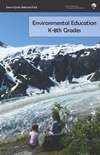
Kenai Fjords National Park offers a landscape that few people in the world get to see without great effort. For Alaskan students it is a place to witness geological forces in action, climate change observed in glacial recession, plant succession laid out in clearly defined steps and animal adaptations that allow for life in an often harsh environment. We hope to see you and your students soon to share the wonders found in your backyard. On this page, you will find a list of the current offerings from our education staff. All programs are free to educational groups. Clicking a link will bring you further down to that topic. 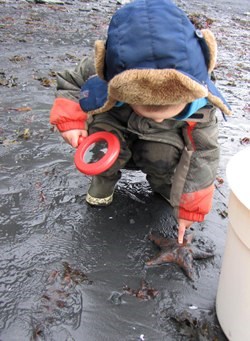
NPS Photo Marine Programs
Tidepool Trekking for K-2nd grades
This program begins with a 40 minute classroom discussion of tides and tide pool etiquette followed by a 90 minute hands-on exploration of the local intertidal ecosystem of Lowell Point State Park. Offered through cooperation with the state park, a national park ranger guides students in a safe -for both creatures and students- and fun encounter with the invertebrates of the intertidal. Due to the fragility of the Lowell Point Ecosystem this program is offered on a limited basis.
Beach Ecosystems for 2nd & 3rd grades
A 75 minute trip to Seward's Fourth of July Beach will reveal living and non-living wonders of the local ecosystem. Students will learn about plankton, tides, algae, marine mammals, invertebrates, fresh and salt water and how these things interact in the ecosystem. This program also emphasizes biodiversity and our role as stewards to these places.
Getting to Know Algae for 5th & 6th grades
Students will visit Fourth of July Beach at low tide and look at algae that feed, protect and cover the intertidal ecosystem. This is a great 1.5 hour lesson for those looking at classification, because some algae still baffle scientists as to their exact origins. Students will examine several species of algae from three readily available phlya.
Piecing Together the Fjord Estuary Ecosystem Puzzle for 5th-7th grades
A 2 hour walk along Seward's waterfront gives students a look into past glacialogy, and present day estuary dynamics. Student groups will have a backpack of supplies to aid in their observations of the area. Participants will be asked to consider essential questions such as: How does geology influence human land use in the Resurrection Bay area? Students' observations can be used to fuel further discussion or a project in the classroom.
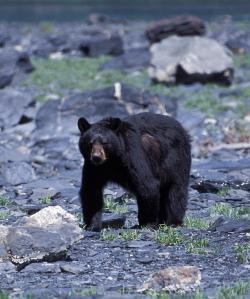
NPS Photo Home Sweet Home for K-1st grades
This 2 hour program is designed to be a first field trip experience for young students. Students will get a chance to explore the Exit Glacier area, visiting park rangers at several stations to learn about how wildlife survive near and in a glacier. Hands on activities keep students engaged and informed about the place these creatures call home.
Thinking About Bears for 3rd-6th grades
This 45 minute PowerPoint presentation generates questions and comments from students and gets them thinking about bears. The program is a useful tool in the Fall when bears are often seen preparing for hibernation, or in Spring when students may be spending a lot of time outside.
This 2 hour walk focuses on how the rock cycle is activley changing the Exit Glacier area, as well as how it has shaped this landscape over time. Students will witness the processes of the rockcycle and learn how geology effects their lives.
Habitat is Where I'm At (indoors-based) for 1st & 2nd grades
This program brings a park ranger to your classroom for a 45 minute visit. The ranger will read a story about animals in Kenai Fjords National Park and help students understand what makes up a creature's habitat.
Habitat is Where I'm At (outdoors-based) for 1st & 2nd grades
The classroom visit is followed up with a trip to Kenai Fjords National Park. On a 1.5 hour walk with a ranger, students will explore the habitat of animals that make their home near a glacier. Students will also answer the question "What is my habitat?"
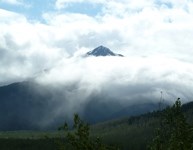
NPS / Katie Peck Water Cycle Programs
This 1.5 hour class has two parts- a PowerPoint presentation that will help students learn to identify clouds and a drawing portion that will help students keep a cloud journal. These activities work well with a unit about the water cycle in your classroom, and as a pre-visit for the 'Water, Water Everywhere' field trip.
Water, Water Everywhere for 3rd-5th grades
This 2 hour walk is the perfect follow up to the classroom cloud program. Students will observe trees transpiring and groundwater seeping to the surface. They will discuss meltwater and weather and identify how each part of the weather cycle impacts the Exit Glacier area.
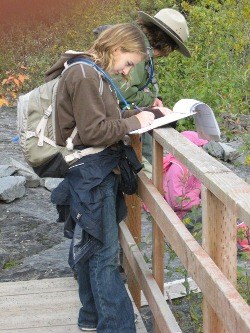
NPS Photo Finding Your Way in the World for 6th grade
This 1.5 hour program is a pre-visit component to 'Botany by GPS'. Students will become familiar with GPS units and plant ID books that they will later use to find plants at Exit Glacier. Students will learn how GPS works and why having a common language for location is so important. Rangers will provide plant books and GPS units that classes can keep until their field trip.
In this practical application of 'Finding Your Way in the World' students spend 2.5 hours exploring the Exit Glacier trails finding and photographing plants and other things they notice along the way. Teachers are encouraged to extend this lesson by having students create photo presentations to share what they've learned at Kenai Fjords National Park.
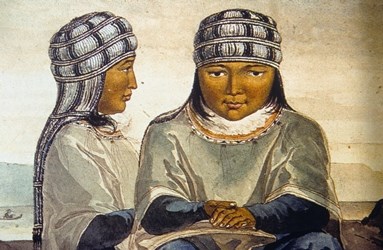
NPS Photo The People of the Park: Native Alutiiq Curriculum for 2nd-5th grades
This unit focuses on the ways people used to live on the land that is now Kenai Fjords National Park. Students will examine how weather and water influenced where homes were built. They will investigate how houses were constructed, how food was gathered, how clothing was made, and how transportation was managed. The activities and lessons take 3-8 class periods to complete.
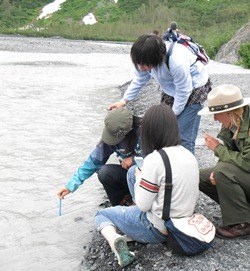
NPS Photo Glacier Programs
What's in a National Park? for 3rd-5th grades This 50 minute classroom visit by a park ranger will introduce students to the concept of National Parks. From there they will look at the reasons why individual parks were created and then examine the reason for Kenai Fjords National Park. Students will learn about the Harding Icefield and its connection to the park's glaciers. This program is designed as a precursor to the Glacier Tracks program.
Glacier Tracks for 3rd-5th grades
Students will hike for 2.5 hours on the trails at Exit Glacier exploring the effects of glacial advance and recession on the landscape.
On this 2 hour walk, students will explore changes in plant life from the outwash plain to the spruce/hemlock forests surrounding Exit Glacier. They will gain an understanding of the ongoing, dynamic process of succession and their own impacts on a landscape in transition.
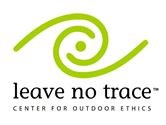
www.lnt.org "Leave No Trace" for 1st-6th grades This program covers the seven "Leave No Trace" principles as introduced by the Peak program. Students will spend 1.5 hours on the trails at Exit Glacier exploring their impact on the ecosystem.
|
Last updated: September 11, 2021
